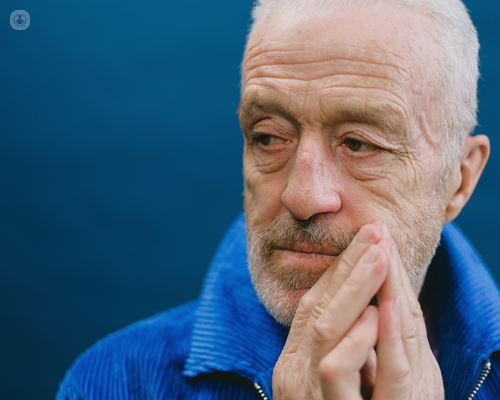Can you feel the force? How laser prostatectomy can improve urinary function
Written by:Laser prostatectomy is a type of procedure used to treat an enlarged prostate, that in turn helps to improve urinary function.
Highly-esteemed consultant urological surgeon Mr Zafar Maan offers expert insight into the procedure itself, possible side effects and the recovery process.

What is laser prostatectomy?
Laser prostatectomy is basically a way of using a laser instead of an electric loop to create a channel through the prostate to help you pass water more easily. That might be suitable for a patient who's got really chronic urinary tract symptoms like straining to pass water, or getting up too much at night. Or it might be for someone who's actually already gone into urinary retention, and is enduring the discomfort of having an indwelling urethral catheter.
How does it differ from transurethral resection of the prostate (TURP)? Is it better?
TURP is the old-fashioned way of creating a hole through the prostate to help you pee. It's a time-honoured operation. It's a good operation, it's a standard operation, it's a gold standard to which other operations are measured. The advantage of the HoLEP (Holmium Laser Enucleation of the Prostate) and the reason why it's being argued by many as the new gold standard, is because it's able to cope with much bigger prostates.
It's more definitive, so TURP unfortunately has a reoperation rate; one to two per cent per year accumulative. So, ten years after your TURP operation, you've got a one in five chance of needing another operation whereas that doesn't happen with HoLEP because you remove so much tissue.
The other big advantage is with HoLEP, is that it's great for cautery (a procedure where electricity or chemicals are used to burn tissue in order to close a wound). The Holmium laser that we use is absorbed very easily by haemoglobin, and that means you get very clean cuts and very little bleeding.
The follow-on advantage for that from the patient's point of view is less time spent in hospital. You can expect to stay in hospital two to three nights after a TURP operation while it’s typically one, or possibly two, nights after a HOLEP operation.
Of course, if you're worried about blood transfusion, the risks are way lower in terms of blood transfusion after a laser prostatectomy.
What does a laser prostatectomy procedure involve?
Just like the TURP, all the cuts are done on the inside. So, there's no cuts on the outside of the body. Everything's done through the tip of the penis. The telescope is passed down through the water passage, the urethra, until you reach the prostate. I quite often say to patients; 'Imagine at this point that the prostate is an orange, and if you have a healthy prostate, you'd have a nice, big hole at the north pole and a channel down to the south pole and you'd pee through the middle of it'. Because we pee through the middle of our prostate, a bit like an American doughnut if you like.
So, what you do, returning to the orange analogy, with the laser prostate, is you pass the telescope down the penis and arrive at the south pole of the prostate. You use the laser a bit like you might use your thumb to separate the orange peel from the orange skin. You leave the peel of the orange behind. In other words, you don't take the entire prostate but you get rid of all the fleshy tissue in the middle that's causing the obstruction, and that floats off into the bladder and we use a special machine to suck it out. Then that leaves you with a nice big hole at the top of the north pole of the prostate, a nice big cavity in the middle, and a nice hole at the south pole. And that's how you're able to pee afterwards.
What are the possible side effects?
In general terms, after any operation there's always a risk of clots to the legs, lungs, heart and brain, which is the scary bit, right? The risk goes up if you are on any blood-thinning medication. If you are, you'd need to stop it for a short period and we recently published a protocol on how to stop these with the best safety, especially for NOAC (novel oral anti coagulants) such as apixaban or rivaroxaban which patients are often on.
In terms of the procedure itself, the main concern is urinary incontinence. The risk of urinary incontinence is only one to two per cent. That compares with TURP, where the risk is 0.5 to one per cent. So, the risk of incontinence is slightly higher with the laser prostatectomy.
You can expect to be incontinent on and off, just occasionally for the first few months and that's normal. A lot of patients have very large prostates and their pelvic floor muscles haven't had to be used for a very long time, so there's sort of a process of re-training that happens at that point.
Some patients, about one in seven patients, may notice an effect on their erections, and it's very common, just like TURP, to have a phenomenon called retrograde ejaculation, which is where the gentleman will have a dry orgasm, basically. All the ejaculate goes back up into the bladder, which is harmless and obviously gets peed out later.
Those are the main complications, and there's a really good leaflet on our website, the Anglian Urology Associates website, so that's worth having a look at. It's our procedure-specific information sheet, which goes into more detail and has a nice video.
What does recovery after a laser prostatectomy procedure look like?
So, after the operation which may done under a general anaesthetic, it may be done under a spinal anaesthesia, depending on fitness and so on. The patient will wake up with a catheter in. The type of catheter is what's called a three-way catheter, there may be bit of bloody urine coming out and there may be some irrigation fluid going in, and that stays typically in for about twelve hours or so.
The following morning, the catheter is removed and the nurses on the ward will check that you're able to pass water okay and will probably do a little scan of your bladder to make sure that you're emptying your bladder properly before you go home.
After that, you've got to be really careful:
- No heavy lifting;
- Not too many domestic chores.
You've got to take it nice and easy. Walking is fine but nothing more than that, really, for the first three or four weeks, and that means everything can seal up nicely and you don't get any bleeding. You need a bit of rest and recuperation, really, while still remaining active. In terms of follow up, the catheter's come out and the patient has gone home.
We will send the tissue that we get from the laser prostatectomy off the lab, and that gets looked at under the microscope and then your urologist will see you, normally about three months down the line with the results of that, and to check how you're doing. Basically, the recovery's good and you're going to feel okay.
People quite often need to be near a toilet during those first few days because their bladder hasn't been able to function quite so well. People are quite often wowed by the force and power of their urinary flow, because they haven't been unobstructed for such a long time. I like doing this operation because the feedback is good and patients come back happy.
If you’re considering undergoing a laser prostatectomy and would like more information, you can book a consultation with Mr Maan by visiting his Top Doctors profile.


